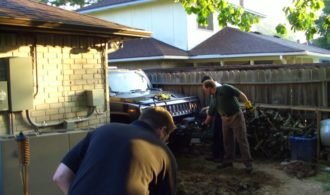The biggest investment that most people make is buying a house. By maintaining your home, you can retain the value of your investment and see it grow, but that investment can sometimes be in danger if your home has foundation problems. Being able to recognize foundation issues can help you save your home and help retain its value.
Why Foundations Fail
The foundation of any building, including your house, is responsible for holding the structure upright. A foundation is primarily concrete poured over steel, with the steel helping to reinforce the concrete and giving it strength. However, over time, a foundation can fail for several reasons.
Soil Problems
One of the most common reasons that house foundations fail is the soil beneath the foundation expands and contracts. Clay soil is one of the main culprits when it comes to causing foundation issues because it can expand or shrink due to natural climate changes. During the rainy season, soil with a high clay content can swell, causing the home’s foundation to lift in areas where the weight of the home is the lightest. Then, during the dry season, the soil contracts, and the foundation resettles back into place.
Having trees and other plants near your home can also cause the soil to dry out, because of something called transpiration. Transpiration occurs when plants, such as trees, remove moisture from the soil, which is common when the weather is hot and dry. This will speed up soil shrinkage or contraction, which can lead to the damage of your home’s foundation.
Poor Drainage
Another reason that many foundations fail is because there are drainage issues, which can cause the soil beneath the foundation to shift or be washed away. Most water drainage issues can be prevented by repairing the gutters, cleaning debris out of the home’s gutters, or extending downspouts, so the water is directed away from the home’s foundation. However, if a foundation has settled unevenly, then water can get beneath it and eat away at the concrete, leading to more severe foundation damage.
Poor Compaction
If the fill material used in your home’s solid foundation is not compacted correctly to hold the weight of the house, then the foundation will fail. Along with improper compaction, using salty or sandy soil or too much water to mix the concrete, can cause issues with the foundation, as well.
Spotting Foundation Problems
If you are aware of the damage caused by a failing foundation, then you can usually spot foundation issues before they become too severe. Spotting these issues early allows you to get them repaired and shore up your foundation, preserving the value of your property. Here are some of the more common signs of foundation problems.
Damage at the Top of the House
While you may think that the first place foundation problems occur is at ground level, that isn’t necessarily true. Often, the first indications of foundation problems are spotted toward the top of the house. Using a ladder, inspect the top story of your house and look for issues like cracks above the window frames. This is one of the first areas that will become damaged when the house shifts during the early stages of a foundation failure.
Stair-Step Cracks
If you have a brick home, a sign of a shifting foundation is the separation of the bricks in a stair-step pattern. This problem is often due to too much moisture seeping beneath the structure’s foundation, which can be the result of something as simple as a clogged gutter.
Bulges in Walls
The walls of your foundation should be basically straight, so if they appear curved, or if you see bulges in them, this is an indication of foundation damage. This problem could be the result of the foundation shifting, or a sign that the soil has expanded and contracted, which can put pressure on the foundation’s walls.
Weakened Concrete
While some cracks in the poured concrete of a foundation are to be expected, the concrete should still be hard. However, if you see any peeling or flaking of the concrete, you should probe it with a strong screwdriver to test it for weakness. If you can chip or break off some of the concrete, then it could be the result of a poor fill mix or too much water was used to mix the concrete.
Cracks in Walls
When the foundation of your home has shifted, it will often cause visible cracks in the walls. A crack running at a forty-five-degree angle is an indication of a serious shift in the foundation, which caused the drywall to come apart.
Sticking Doors or Windows
If your doors or windows stick when you try to open or close them, or if they don’t close at all, this could be caused from the foundation shifting. As a result of the shifting, door and window frames can twist, making it difficult to use them.
Getting Foundation Repairs
Fortunately, many foundation problems can be easily repaired, which will help preserve the value of your home. If you spot any of the problems previously listed, you should contact a foundation repair company and have them inspect your property. They will examine the damage and access it to see what is causing the issues, and they will tell you how the foundation can be repaired.
The house may have to be jacked up and placed on a temporary foundation for the original foundation to be replaced, or the company may use piling techniques to repair or replace damaged piles in deeper foundations. Underpinning is another technique that is used to repair solid house foundations that have been compromised. The foundation repair company will discuss the repair options with you, and they may be able to show you how to prevent foundation issues from occurring in the future.
If not repaired, a damaged foundation will continue to deteriorate, and it will eventually collapse or buckle. If this happens, your home can be destroyed, and you will lose your most valuable investment. Call immediately for an estimate when you spot any indication of foundation damage.





If you are experiencing water damage in your home or office, then it is imperative that you contact a water damage restoration company to come out and assess the situation. Once they have done so, they will be able to take the necessary steps to mitigate the damage. Along with assessing the property, one of their main priorities will be to dry out the premises as quickly as possible. This is because prolonged exposure can lead to mold growth, which can create health risks for anyone present in the building. Call a professional to help with clean-up and restoration as soon as possible! Thanks for sharing this post with us.